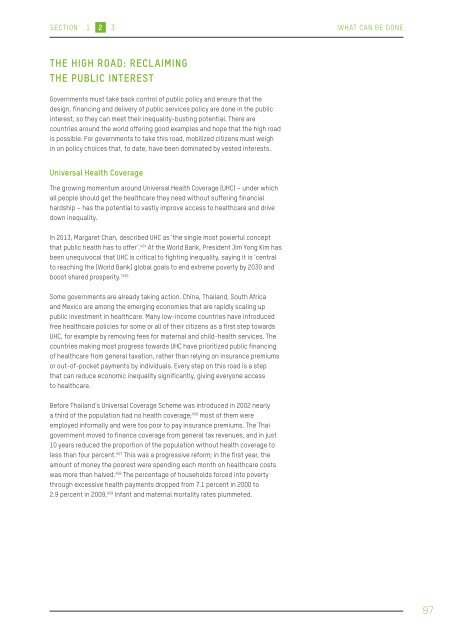1FW2e8F
1FW2e8F
1FW2e8F
Create successful ePaper yourself
Turn your PDF publications into a flip-book with our unique Google optimized e-Paper software.
SECTION 1 2 3<br />
WHAT CAN BE DONE<br />
THE HIGH ROAD: RECLAIMING<br />
THE PUBLIC INTEREST<br />
Governments must take back control of public policy and ensure that the<br />
design, financing and delivery of public services policy are done in the public<br />
interest, so they can meet their inequality-busting potential. There are<br />
countries around the world offering good examples and hope that the high road<br />
is possible. For governments to take this road, mobilized citizens must weigh<br />
in on policy choices that, to date, have been dominated by vested interests.<br />
Universal Health Coverage<br />
The growing momentum around Universal Health Coverage (UHC) – under which<br />
all people should get the healthcare they need without suffering financial<br />
hardship – has the potential to vastly improve access to healthcare and drive<br />
down inequality.<br />
In 2013, Margaret Chan, described UHC as ‘the single most powerful concept<br />
that public health has to offer’. 454 At the World Bank, President Jim Yong Kim has<br />
been unequivocal that UHC is critical to fighting inequality, saying it is ‘central<br />
to reaching the [World Bank] global goals to end extreme poverty by 2030 and<br />
boost shared prosperity.’ 455<br />
Some governments are already taking action. China, Thailand, South Africa<br />
and Mexico are among the emerging economies that are rapidly scaling up<br />
public investment in healthcare. Many low-income countries have introduced<br />
free healthcare policies for some or all of their citizens as a first step towards<br />
UHC, for example by removing fees for maternal and child-health services. The<br />
countries making most progress towards UHC have prioritized public financing<br />
of healthcare from general taxation, rather than relying on insurance premiums<br />
or out-of-pocket payments by individuals. Every step on this road is a step<br />
that can reduce economic inequality significantly, giving everyone access<br />
to healthcare.<br />
Before Thailand’s Universal Coverage Scheme was introduced in 2002 nearly<br />
a third of the population had no health coverage; 456 most of them were<br />
employed informally and were too poor to pay insurance premiums. The Thai<br />
government moved to finance coverage from general tax revenues, and in just<br />
10 years reduced the proportion of the population without health coverage to<br />
less than four percent. 457 This was a progressive reform; in the first year, the<br />
amount of money the poorest were spending each month on healthcare costs<br />
was more than halved. 458 The percentage of households forced into poverty<br />
through excessive health payments dropped from 7.1 percent in 2000 to<br />
2.9 percent in 2009. 459 Infant and maternal mortality rates plummeted.<br />
97


